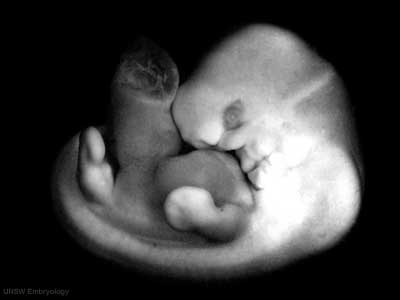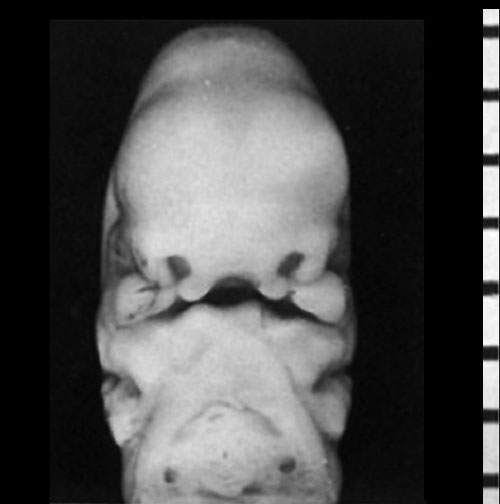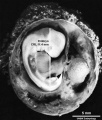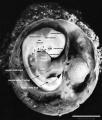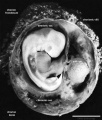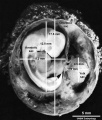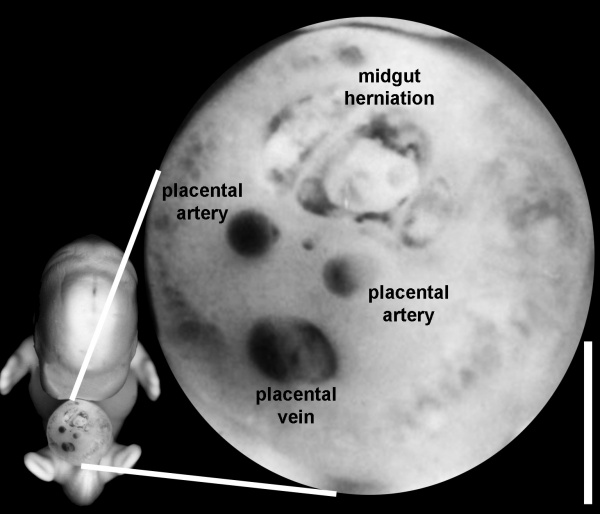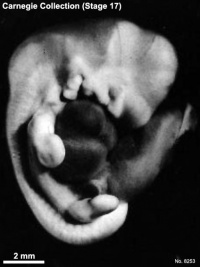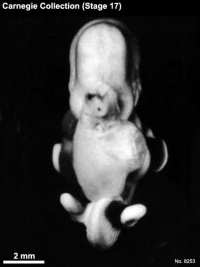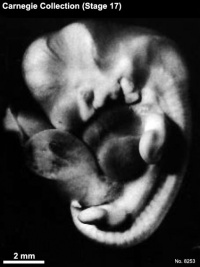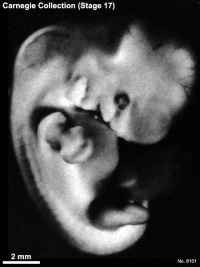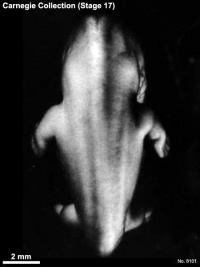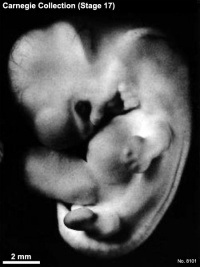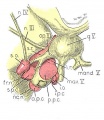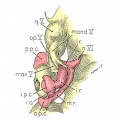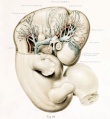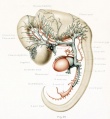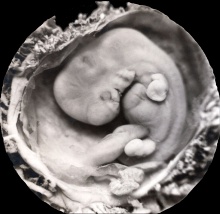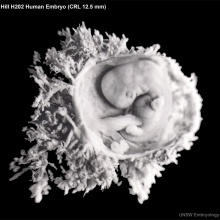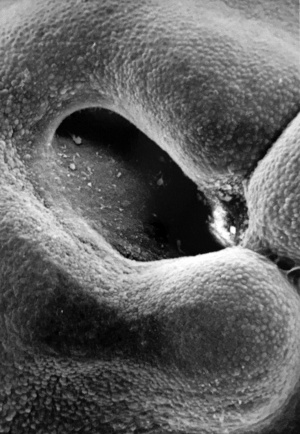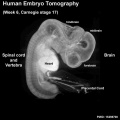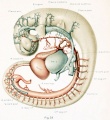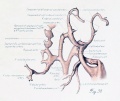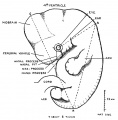Carnegie stage 17
| Embryology - 27 Apr 2024 |
|---|
| Google Translate - select your language from the list shown below (this will open a new external page) |
|
العربية | català | 中文 | 中國傳統的 | français | Deutsche | עִברִית | हिंदी | bahasa Indonesia | italiano | 日本語 | 한국어 | မြန်မာ | Pilipino | Polskie | português | ਪੰਜਾਬੀ ਦੇ | Română | русский | Español | Swahili | Svensk | ไทย | Türkçe | اردو | ייִדיש | Tiếng Việt These external translations are automated and may not be accurate. (More? About Translations) |
Introduction
Facts
Week 6, 42 - 44 days, 11 - 14 mm
Gestational Age GA week 8
Summary
- Ectoderm: sensory placodes, lens pit, otocyst,nasal pits moved ventrally, fourth ventricle of brain
- Mesoderm: heart prominence
- Head: 1st, 2nd and 3rd pharyngeal arch, forebrain, eye, auricular hillocks
- Body: heart, liver, umbilical cord, mesonephric ridge
- Limb: upper and lower limb buds, hand digital rays
See also Carnegie stage 17 Events
Features
- pigmented eye, nasal pit, nasolacrimal groove, external acoustic meatus, auricular hillock, heart, digital rays, liver pronminance, thigh, ankle, foot plate, umbilical cord
- Identify: pigmented eye, nasal pit, nasolacrimal groove, external acoustic meatus, auricular hillock, heart, digital rays, liver prominence, thigh, ankle, foot plate, umbilical cord
| Week: | 1 | 2 | 3 | 4 | 5 | 6 | 7 | 8 |
| Carnegie stage: | 1 2 3 4 | 5 6 | 7 8 9 | 10 11 12 13 | 14 15 | 16 17 | 18 19 | 20 21 22 23 |
- Carnegie Stages: 1 | 2 | 3 | 4 | 5 | 6 | 7 | 8 | 9 | 10 | 11 | 12 | 13 | 14 | 15 | 16 | 17 | 18 | 19 | 20 | 21 | 22 | 23 | About Stages | Timeline
Kyoto Collection
View: This is a left lateral view of embryo. Amniotic membrane removed.
Ventral view of head region (1 mm scale).
- Human Embryo (Carnegie stage 17)
Right lateral view of embryo enclosed in chorionic sac. scale bar 5 mm.
Kyoto embryo (16834) showing detail of umbilicus Carnegie stage 17 (1 mm scale bar)
|
This is a MRI off-axis sagittal (not in at the exact anatomical plane) section through the week 6 embryo |
Image source: The Kyoto Collection images are reproduced with the permission of Prof. Kohei Shiota and Prof. Shigehito Yamada, Anatomy and Developmental Biology, Kyoto University Graduate School of Medicine, Kyoto, Japan for educational purposes only and cannot be reproduced electronically or in writing without permission.
Carnegie Collection
| Carnegie Collection Embryos - Stage 17 | ||||||||||
|---|---|---|---|---|---|---|---|---|---|---|
| Serial No. | Size (mm) | Grade | Fixative | Embedding Medium | Plane | Thinness (µm) | Stain | Year | Notes | |
| 353 | E, 11.0 Ch., 40x35x20 | Good | Formalin | P | Coronal | 10 | (Stain - Haematoxylin Eosin) | 1906 | Very advanced | |
| 485 | E, 13.0 Ch., 33x25 | Exc. | Formalin | P | Coronal | 40 | Al. coch. | 1911 | Injected (India ink) | |
| 544 | E., 11.5 Ch., 30 | Good | Zenker-Formol | P | Sagittal | 40 | Al. coch. | 1911 | Operative Injected (India ink) | |
| 562 | E, 13.0 Ch., 28x17x17 | Poor | Formalin | P | Sagittal | 100 | Al. coch. | 1912 | Advanced | |
| 623 | E 10.1 | Good | Alc. | P | Transverse | 20 | H. & Congo red | 1912 | Operative. Median in group | |
| 695 | E, 13.5 Ch., 40x40x17 | Poor | Formalin | P | Transverse | 10 | H. & Congo red | 1913 | Macerated | |
| 916 | E, 11.0 Ch, 30x30x16 | Good | Bouin | C | Transverse | 40 | H.&E, or. G. | 1915 | Most-advanced third | |
| 940 | E, 14.0 Ch, 28x23x21 | Good | Formalin | C | Transverse | 40 | H.&E, or. G. | 1914 | Advanced | |
| 1232 | E, 14.5 Ch., 35x35x30 | Poor | Formalin | P | Coronal | 40 | Al. coch. | 1915 | Close to No.1267A | |
| 1267A | E-a 145 Ch., 35x30x26 40 | Good | Formalin | C | Sagittal | 20 | (Stain - Haematoxylin Eosin). or. G | 1915 | Excellent CN.S. | |
| 1267B ?? | E, 125 | Good | Formalin | p | Sagittal | 20 | (Stain - Haematoxylin Eosin) | 1917 | Tubal | |
| 5642 | E, 11.5 Ch.. 33x30x17 | Good | Formalin | p | Transverse | 15 | Al. coch. | 1928 | Right upper limb injured | |
| 5893 | E.. 13.2 | Good | Formalin | C-P | Transverse | 20 | Al. coch. | 1929 | Most advanced in group | |
| 6258 | E. 14.0 Ch 48x35x25 | Good | Formalin | C-P | Transverse | 10 | (Stain - Haematoxylin Eosin) | 1930 | Median in group | |
| 6519 | E.. 10.8* | Exc | Corrov acetic | C-P | Sagittal | 8 | Al. coch. | ? | Least-advanced or middle third | |
| 6520 | E., 14.2* | Exc. | Corros. acetic | C-P | Transverse | 10 | Al. coch. | P | Median in group. Ag added to slides 1-25 | |
| 6521 | E., 13.2* | Exc. | Corros. acetic | C-P | Transverse | 8-18 | Al. coch. | ? | Sections vary in thinness | |
| 6631 | E., 13.0 | Good | Formalin | C-P | Coronal | 10 | (Stain - Haematoxylin Eosin) | 1932 | Tubal. Advanced | |
| 6742 | E, 11.0 Ch.,50x40x15 | Good | Formalin | C-P | Transverse | 12 | H. & phlox. | 1933 | Good primary germ cells | |
| 6758 | E., 12.8 | Good | Formalin | C-P | Transverse | 10 | H. & phlox. | 1933 | Least—advanced third | |
| 7317 | E, 10.0* | Good | P | Coronal | 10 | (Stain - Haematoxylin Eosin) | 1936 | His embryo “Ru." Every third section | ||
| 7436 | E., 13.0 | Good | Formalin | C-P | Coronal | 30 | Al. coch. | 1937 | Most-advanced third | |
| 8101 | E., 13.0 | Exc. | Bouin | C-P | Transverse | 10 | (Stain - Haematoxylin Eosin) | 1943 | Operative | |
| 8118 | E., 12.6 | Exc. | Bouin | C-P | Coronal | 10 | (Stain - Haematoxylin Eosin) | 1943 | Middle third | |
| 8253 | E., 11.2 Ch.,30x20x10 | Good | Bouin | C-P | Coronal | 10 | Al. coch., phlox. | 1944 | Operative. Least advanced in group | |
| 8789 | E., 11.7 | Exc. | Bouin | C-P | Sagittal | 10 | Azan | 1950 | ||
| 8969 | E., 11.2 | Exc. | ? | p | Transverse | 15 | Azan | 1919 | Univ. Chicago No. H566 | |
| 8998 | E., 11.0 | Exc. | ? | C-P | Coronal | 10 | Azan | 1952 | ||
| 9100 | E., 12.0 Ch., 12x13x10 | Exc. | Formol-chrom. subl. | C-P | Sagittal | 10 | Azan | 1933 | Univ. Chicago No. H1475 | |
| 9282 | E, 12.0 Ch., 16 | Good | Ale. | p | Transverse | 15 | Ag | 1955 | Mislaid | |
Abbreviations
| ||||||||||
| iBook - Carnegie Embryos | |
|---|---|
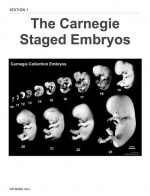
|
|
- Eye, muscle primordia, and associated nerves
Embryo 6258 Eye muscle primordia
Embryo 6258 Brain, eye, principal nerves
Embryo 6258 Dorsocranial aspect
Embryo 6258 Ventrocaudal aspect
Blechschmidt Collection
|
Model from serial section reconstruction.
|
Image source: The Blechschmidt Collection images are reproduced with the permission of Prof. Christoph Viebahn, director of the Institute of Anatomy and Embryology, , University Medical Center Göttingen. Images are for educational purposes only and cannot be reproduced electronically or in writing without permission.
Hill Collection
| Hill H58 | |
|---|---|
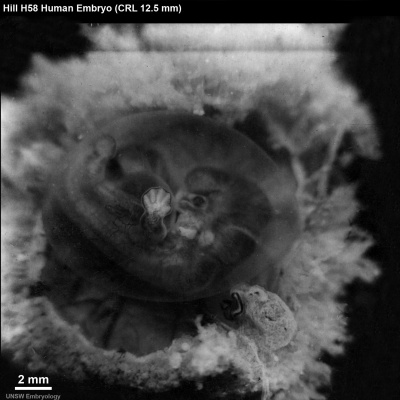
|
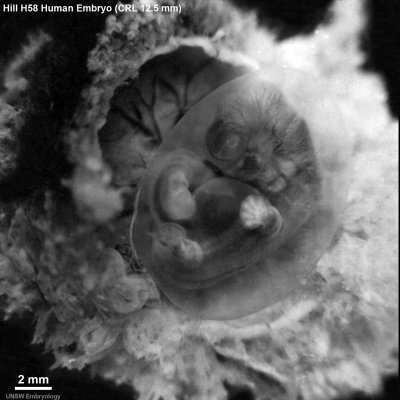
|
| left dorsolateral | left lateral |
| Hill H202 | |
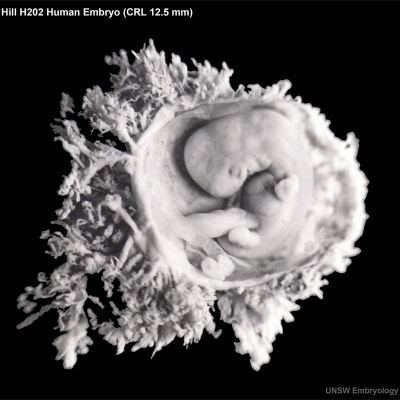
|
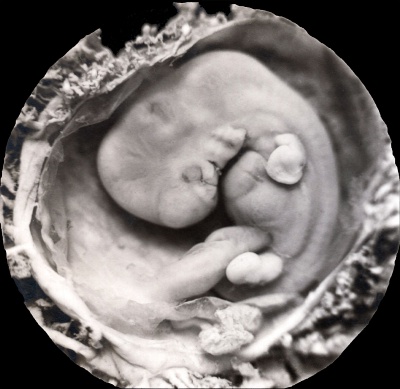
|
Embryo Virtual Slide
|
|
Image source: The images from the Hill Collection (part of the Embryological Collection) are reproduced with the permission of the Museum für Naturkunde, Leibniz Institute for Research on Evolution and Biodiversity. Images are for educational purposes only and must not be reproduced electronically or in writing without permission from the Museum für Naturkunde Berlin.
Hinrichsen Collection
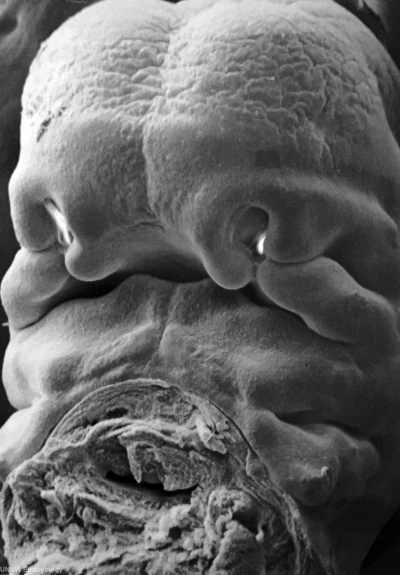
|
Hinrichsen collection Human Embryo ME16 (stage17).
Note the developing mandible and maxilla in this ventrolateral view of the head. The developing maxilla in this ventral view of the nasal opening.
|
Image source: The Hinrichsen Collection images are reproduced with the permission of Prof. Beate Brand-Saberi, Head, Department of Anatomy and Molecular Embryology, Ruhr-Universität Bochum. Images are for educational purposes only and cannot be reproduced electronically or in writing without permission.
Madrid Collection
| Madrid Collection Embryos | ||||||
|---|---|---|---|---|---|---|
| Carnegie Stage |
Embryo | Days | CRL (mm) | Section thickness |
Staining | Section plane |
| 17 | CN 4 | 41 | 11 | 10 | (Stain - Haematoxylin Eosin) | transverse |
| 17 | J1 | 41 | 11.5 | 10 | Bielschowsky (Stain - Haematoxylin Eosin) | frontal |
| 17 | MAR 4 | 42 | 12 | 10 | (Stain - Haematoxylin Eosin) | transverse |
| 17 | VE-4 | 43 | 12.5 | 10 | (Stain - Haematoxylin Eosin) | transverse |
Scanning EM
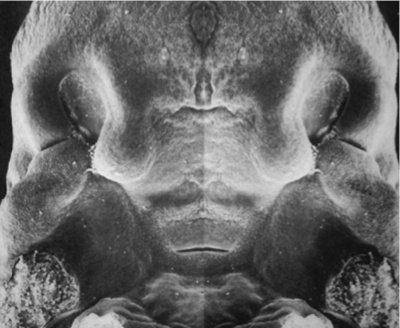
|
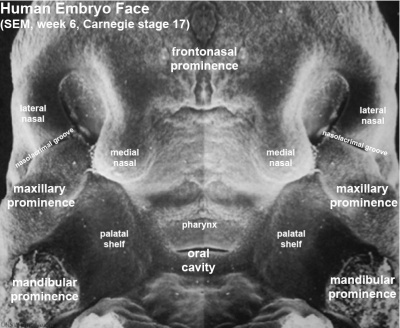
|
| Ventral view of head showing upper lip, maxilla and nasal region. | Note that a ventral image of only half the head has been "mirrored" to generate this image.
Image Source: Prof Virginia Diewert |
Movies
MRI
| MRI Stage 17 |
| Page | Play |
Tomography
Optical projection tomography movie of rotating stage 17 embryo. Note the detailed structural view of neural system development. |
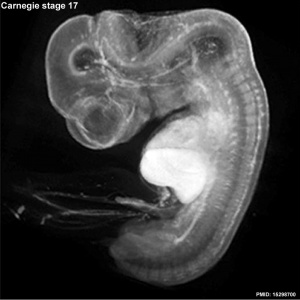
Stage 17 Optical Projection Tomography (left) |
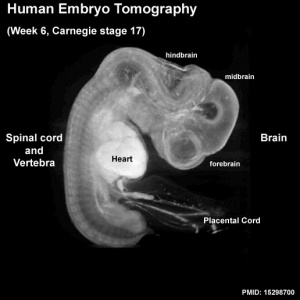
Stage 17 Optical Projection Tomography (right) |
- Links: Movies
Other Specimens
Volcher R. Le systeme nerveux pe'riphe'rique cninien d'un embryon humain de 12 mm. (1959) Arch. Biol. (Liege), 70:179-215. describes the peripheral nervous system.
Hendrix MJ Brailey JL and Shenker L. SEM-dissection of a human embryo derived from an ectopic pregnancy. (1985) Early Hum Dev. 11(1): 61-8. PMID 4006825
Events
- neural
- hearing - otic capsule now dense mesenchyme. Otic vesicle elongated along the dorso-ventral axis and differentiated into the end lymphatic appendage and cochlear duct.[3] Otic vesicle vestibular part wall thins prior to semicircular duct appearing. Geniculate ganglion forms. Auditory ossicles, tubotympanic recess and chorda tympani appear. First pharyngeal groove (cleft or hyomandibular groove) begins to form the concha and the external acoustic meatus. Six auricular hillocks present (1 tragus, 2 and 3 crus helicis, 4 and 5 helix, and 6 antitragus).
- smell olfactory nerve fibres enter the brain[4] The olfactory nerve is organized into two plexuses, lateral and medial, the latter mingled with the terminal-vomeronasal complex.[5] Stages Description | primitive olfactory bulb
- Vision - Retinal pigment is visible and the retinal fissure is largely closed. Eyelids grooves deepen, eyelid folds develop, first below, and then above, the eye.[6]
- eyelid sulcus (groove) above and below eye deepen and eyelid folds develop (below first and then above)[6]
- diaphragm - pleuroperitoneal fold (PPF) no longer separated from the diaphragm (CRL 14mm)[7]
- Abdominal Wall muscle cells now migrated approximately 50% of the distance to the ventral midline, inner and outer layers were not discernible yet.[8]
- cardiovascular
- coronary circulation acquires coronary sinus connection.[9]
- endocrine[10]
- Hypophysis - juxtacerebral wall of the craniopharyngeal pouch is the thicker. The lateral lobes (future infundibular, or tuberal, part) and the anterior chamber (Vorraum) are clearly visible (O'Rahilly 1973 a). The infundibular recess displays a characteristically folded wall, namely the neurohypophysis (O'Rahilly 1973 a).
- thymus - connection of the thymus with the pharynx has been severed (Weller 1933). The thymus is intimately approximated to the cervical duct (ibid.) According to Norris (1937), both third and fourth pouches make contact with the ectoderm, although only the third "receives an increment from the ectoderm".
- parathyroid - parathyroid 4 is attached to the lateral surface of what Weller (1933) termed the "lateral thyroid component"
- thyroid The lobes of the thyroid curve around the carotid arteries and are connected by a delicate isthmus. Lacunae "should not be confused with lumina of follicles" (Weller 1933).
- adrenal Cortex - dorsal part of the whole suprarenal primordium is disorganized by the invasion of sympathetic nerves and cells, while the band of C2 cells and the coelomic epithelium remain intact (Crowder 1957).
- adrenal Medulla - first neural migration is at its height. Growth of the para-aortic complex is extensive. The plexiform complex is derived from paravertebral sympathetic ganglia T6-12 and usually L 1. Included in it are the primordia of the suprarenal medulla and of the celiac, superior mesenteric, and renal plexuses. Nerve fibres and "paraganglion" (M3) cells enter.
- pancreas - ventral pancreas has now fused with dorsal (Streeter 1948). Perhaps the ventral and dorsal ducts have begun to blend (Russu and Vaida 1959).
- meninges (spinal cord) - vertebral rudiments stand out more and more distinctly from the intermediate zone. Over the dorsal surface of the spinal cord the closure membrane is separating into a peripheral and denser body-wall portion and a deeper and looser portion. The latter becomes part of the meninx primitiva, and this can be identified everywhere about the cord. The meninx primitiva has broadened, and its cells are more scattered than in the previous age group. It is deepest ventral to the neural tube and in the lateral parts between adjacent ganglia. The ganglia have migrated so that their ventral tips lie at the level of origin of the ventral nerve root. The vascular channels now surround the spinal ganglia, and small vessels penetrate into the spinal cord. A frontal section through the ganglia shows extensions of the dense lateral concentrations of the vertebral canal, passing medially between each two adjacent ganglia to become continuous with the meninx adjacent to the cord. These extensions are the first indications of the denticulate ligaments of the pia mater. These primordia of the dentate processes are also observed in transverse sections, forming a cellular concentration between the ventralateral part of the neural tube and the ventral part of the neural arch rudiments.[11]
- limb - neural the median nerve, the radial nerve, and the ulnar nerve enter into the hand plate.[12]
References
- ↑ Müller F & O'Rahilly R. (1989). The human brain at stage 17, including the appearance of the future olfactory bulb and the first amygdaloid nuclei. Anat. Embryol. , 180, 353-69. PMID: 2802187
- ↑ Patelska-Banaszewska M & Woźniak W. (2004). The development of the epidural space in human embryos. Folia Morphol. (Warsz) , 63, 273-9. PMID: 15478101
- ↑ Toyoda S, Shiraki N, Yamada S, Uwabe C, Imai H, Matsuda T, Yoneyama A, Takeda T & Takakuwa T. (2015). Morphogenesis of the inner ear at different stages of normal human development. Anat Rec (Hoboken) , 298, 2081-90. PMID: 26369281 DOI.
- ↑ Müller F & O'Rahilly R. (2004). Olfactory structures in staged human embryos. Cells Tissues Organs (Print) , 178, 93-116. PMID: 15604533 DOI.
- ↑ Bossy J. Development of olfactory and related structures in staged human embryos. (1980) Anat. Embryol., 161(2);225-36 PMID 7469043
- ↑ 6.0 6.1 Pearson AA. The development of the eyelids. Part I. External features. (1980) J. Anat.: 130(1): 33-42. PMID 7364662 PDF
- ↑ Clugston RD, Zhang W & Greer JJ. (2010). Early development of the primordial mammalian diaphragm and cellular mechanisms of nitrofen-induced congenital diaphragmatic hernia. Birth Defects Res. Part A Clin. Mol. Teratol. , 88, 15-24. PMID: 19711422 DOI.
- ↑ Nichol PF, Corliss RF, Yamada S, Shiota K & Saijoh Y. (2012). Muscle patterning in mouse and human abdominal wall development and omphalocele specimens of humans. Anat Rec (Hoboken) , 295, 2129-40. PMID: 22976993 DOI.
- ↑ Hutchins GM, Kessler-Hanna A & Moore GW. (1988). Development of the coronary arteries in the embryonic human heart. Circulation , 77, 1250-7. PMID: 3286038
- ↑ O'Rahilly R. The timing and sequence of events in the development of the human endocrine system during the embryonic period proper. (1983) Anat. Embryol., 166: 439-451. PMID 6869855
- ↑ Sensenig EC. The early development of the meninges of the spinal cord in human embryos. (1951) Contrib. Embryol., Carnegie Inst. Wash. Publ. 611.
- ↑ Shinohara H. Naora H. Hashimoto R. Hatta T. and Tanaka O. Development of the innervation pattern in the upper limb of staged human embryos. (1990) Acta Anat (Basel) 138: 265-269. PMID 2389673
Additional Images
Embryo 544 Streeter 1921 Plate 3
Fig 23 544
Fig 24 544
Embryo 940 cardiovascular lateral view
Embryo 940 cardiovascular ventrolateral view
Embryo 940 cardiovascular ventral view
- Carnegie Stages: 1 | 2 | 3 | 4 | 5 | 6 | 7 | 8 | 9 | 10 | 11 | 12 | 13 | 14 | 15 | 16 | 17 | 18 | 19 | 20 | 21 | 22 | 23 | About Stages | Timeline
Cite this page: Hill, M.A. (2024, April 27) Embryology Carnegie stage 17. Retrieved from https://embryology.med.unsw.edu.au/embryology/index.php/Carnegie_stage_17
- © Dr Mark Hill 2024, UNSW Embryology ISBN: 978 0 7334 2609 4 - UNSW CRICOS Provider Code No. 00098G
